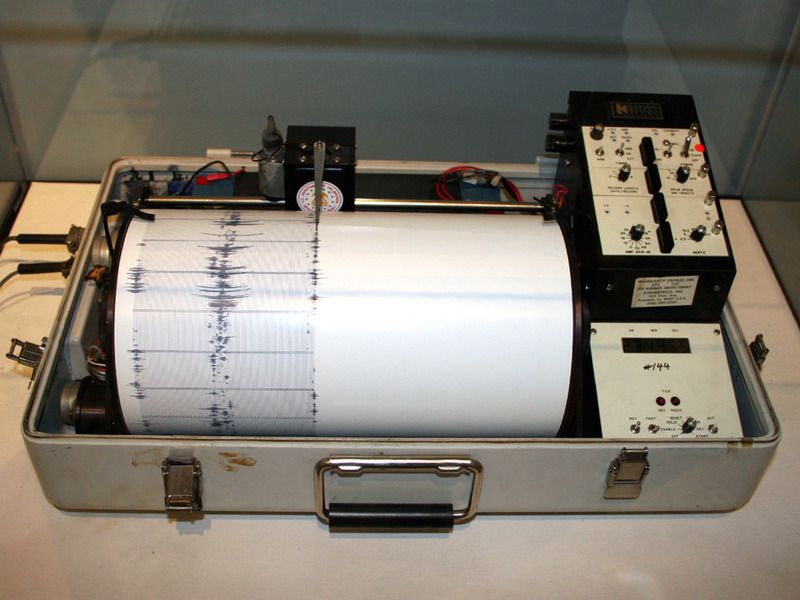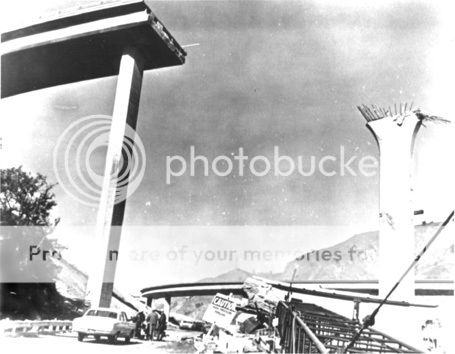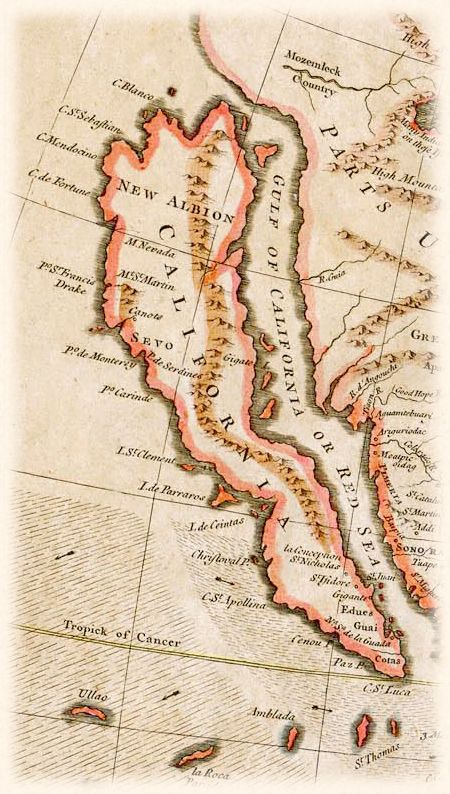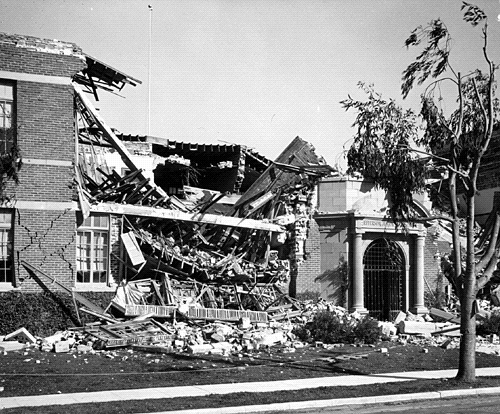ANAHEIM - Over the last few weeks there have been some minor earthquakes in the Los Angeles area. These minor shakers have wiggled the ground just enough to get a lot of people's attention, and making a lot of people wonder what all this shaking may be about. On Sunday, April 12, there was a magnitude (M) 3.3 shaker in the West L.A. area that appears to be on the Newport-Inglewood Fault, on Wednesday, April 15, there was a M3.1 in the Sylmar area, and on Saturday, April 2, there were several minor earthquakes in the Newhall Pass area with the largest quake being M3.2.

Kinemetrics seismograph used by United States Department of the Interior. Photograph used under Creative Commons license.
If you grew up in Southern California, or even Japan, or really anywhere in the world that is considered "earthquake country," you probably have heard immense myths about earthquakes.
Is There Anything To These Earthquake Myths?
The short answer: NO! We all want an answer to the unknowable, especially if it is something that can greatly impact our lives and, frankly, our way of life, within just a few seconds, but at this time there is no scientific data and proof to accurately and precisely predict when a big earthquake will occur. With decades filled with tons of scientific studies, myths about earthquakes have been proven to be just that, myths.
Dolphins and Whales On The Beach
In recent weeks there has been a story floating around that several beached dolphins off the coast of Japan means a big earthquake is going to happen, because this happened once before off the Japan coast days before the great 2011 Japan earthquake. Furthermore, this, the sudden beaching of dolphins and whales, has also happened before large earthquakes in New Zealand and Chile.
Well, the beaching of dolphins and whales has happened in many other places many times before, and there has been no large earthquake in the following days. Thus, there has been no conclusive evidence that beaching of these great sea animals mean a big earthquake is imminent.
Full Moon Pulling The Gravity
Another very common myth is large earthquakes occur when there is a full Moon due to the Moon's gravity pull on earth. Well, out of all these earthquake myths this one has some truth to it as scientists at the United States Geological Survey have, "found a correlation between earth tides (caused by the position of the moon relative to the earth) and some types of earthquakes."
However, please understand that earthquakes can and do happen whether or not the Moon is shining bright in the sky, and thus the Moon is NOT a viable way to predict earthquakes.
Big Shakes Only In The Morning
If you grew up in Southern California you probably remember all too well that our most "memorable" earthquakes occurred early in the morning, which has lead a lot of people to believe only big earthquakes will only happen in the morning. This is a very big myth. The fact that major earthquakes have occurred in Southern California in the morning hours is simply a roll of the dice when Mother Nature has decided to give us a big shake. That is a way of saying it simply is by pure chance that large earthquakes have happened in the morning and there is no scientific proof that significant earthquakes occur in Southern California only in the morning hours. In fact, the 1933 Long Beach Earthquake happened at 5:55 p.m. Bottom line, "The Big One," or the next big enough one, can happen at 4:31 in the morning, or 4:31 in the afternoon.
Earthquake Weather
Probably one of the biggest myths in Southern California is so-called "earthquake weather." The common belief in Southern California is when it suddenly warms up earthquakes will happen. Well, many studies have shown when the earth decides to shake it gives no thought to the weather. After all, there have been major earthquakes in Southern California on Christmas Day and in the middle of summer.
Animals Know When An Earthquake Is About To Happen
Many people have said that right before an earthquake their pet, typically a dog or cat, "acted weird" or suddenly began running about without any reason. In most cases what animals are sensing are the P-Waves of an earthquake, which can be detected by sensitive animals, and sometimes sensitive humans. There have been cases where people report animals acting "weird" a few days before an earthquake. Plenty of studies have been done on this subject, and studies in China in the 1970s thought there might have been a breakthrough with animals helping predict earthquakes. Well, like many studies of possible earthquake precursors and predictions, observing animals has proven to be inconclusive, and thus animals cannot predict earthquakes.
What About Earthquakes Being Predicted To Happen In 20 Years
When geologists and seismologists talk about an earthquake happening either in a certain region or on a certain earthquake fault-line what they are doing is forecasting, not predicting. The words forecast and prediction are sometimes used interchangeably, but they have very different meanings when it comes to seismology. When it comes to earthquakes seismologists, for example, look at the history of a fault-line and how often it has produced a major earthquake, otherwise called paleoseismology. If, for example, a fault-line has produced a major earthquake on average every 100 years and it has been 70 years since the said fault-line last rupture seismologists will forecast the fault-line will produce a major earthquake within the next 30 years. Ostensibly, using our example, if it has been, say, 120 years since the last major earthquake on said fault-line you will hear that we are overdue for a major earthquake.
Caution In Earthquake Forecasting
While paleoseismology has been one of the best breakthroughs in figuring out how often a certain fault-line ruptures it must be stressed that while the average rupture may be, for example, every 100 years, it has also showed what could be best described as anomalies. That is to say even though the fault-line is suppose to cause a major earthquake on average around every 100 years sometimes, as paleoseismology shows, the said fault-line may of had a period in the past where it did not have a major earthquake for 200 or even 300 years.
On the other end, paleoseismology has showed major earthquakes on the studied fault-line, using our example, have occurred less than 100 years apart.
Think of it this way, you know how on the seven-day weather forecast on the seventh day they say a major storm is coming based on all the information on the way the storm pattern is shaping up, and come that seventh day the storm is nowhere to be found and it is very sunny outside. Well, long-term earthquake forecasting is kind of like long-term weather forecasting. Everything is lined up and based on all evidence it looks like an event should happened and thus is forecast to happen, like a big rain storm or big earthquake, but it just fails to happen.
Will There Ever Be Day Where We Can Predict Earthquakes?
Well, never say "never," but in general when it comes to earthquake prediction the geologist and seismologist community has kind of moved on to long-range earthquake forecasting, such as more paleoseismology studies, and developing and funding earthquake early warning systems.
It is very important to understand that the study of earthquakes is an extraordinarily young science and even when major earthquakes have occurred scientists have learned something new. After all, it was the 1994 Northridge Earthquake that showed how dangerous blind thrust faults are to the L.A. area and gave way to more studies of such faults like, The Puente Hills Thrust Fault.
Even though the earth science community in general is moving away from precise earthquake prediction please have no fear, because many professional, retired, government, amateur and wanna-be geologists and seismologists are still looking for that Holy Grail of trying to solve that puzzle of accurately predicting earthquakes.
So, The Bottom Line Is The One Thing Nobody Wants To Hear...
Even with all the marvelous advances in technology there is still no accurate way to predict when precisely a major earthquake will occur. It could happen one minute from now, or another 20 years, or even another 100 years from today. All you can do is prepare.

Kinemetrics seismograph used by United States Department of the Interior. Photograph used under Creative Commons license.
If you grew up in Southern California, or even Japan, or really anywhere in the world that is considered "earthquake country," you probably have heard immense myths about earthquakes.
Is There Anything To These Earthquake Myths?
The short answer: NO! We all want an answer to the unknowable, especially if it is something that can greatly impact our lives and, frankly, our way of life, within just a few seconds, but at this time there is no scientific data and proof to accurately and precisely predict when a big earthquake will occur. With decades filled with tons of scientific studies, myths about earthquakes have been proven to be just that, myths.
Dolphins and Whales On The Beach
In recent weeks there has been a story floating around that several beached dolphins off the coast of Japan means a big earthquake is going to happen, because this happened once before off the Japan coast days before the great 2011 Japan earthquake. Furthermore, this, the sudden beaching of dolphins and whales, has also happened before large earthquakes in New Zealand and Chile.
Well, the beaching of dolphins and whales has happened in many other places many times before, and there has been no large earthquake in the following days. Thus, there has been no conclusive evidence that beaching of these great sea animals mean a big earthquake is imminent.
Full Moon Pulling The Gravity
Another very common myth is large earthquakes occur when there is a full Moon due to the Moon's gravity pull on earth. Well, out of all these earthquake myths this one has some truth to it as scientists at the United States Geological Survey have, "found a correlation between earth tides (caused by the position of the moon relative to the earth) and some types of earthquakes."
However, please understand that earthquakes can and do happen whether or not the Moon is shining bright in the sky, and thus the Moon is NOT a viable way to predict earthquakes.
Big Shakes Only In The Morning
If you grew up in Southern California you probably remember all too well that our most "memorable" earthquakes occurred early in the morning, which has lead a lot of people to believe only big earthquakes will only happen in the morning. This is a very big myth. The fact that major earthquakes have occurred in Southern California in the morning hours is simply a roll of the dice when Mother Nature has decided to give us a big shake. That is a way of saying it simply is by pure chance that large earthquakes have happened in the morning and there is no scientific proof that significant earthquakes occur in Southern California only in the morning hours. In fact, the 1933 Long Beach Earthquake happened at 5:55 p.m. Bottom line, "The Big One," or the next big enough one, can happen at 4:31 in the morning, or 4:31 in the afternoon.
Earthquake Weather
Probably one of the biggest myths in Southern California is so-called "earthquake weather." The common belief in Southern California is when it suddenly warms up earthquakes will happen. Well, many studies have shown when the earth decides to shake it gives no thought to the weather. After all, there have been major earthquakes in Southern California on Christmas Day and in the middle of summer.
Animals Know When An Earthquake Is About To Happen
Many people have said that right before an earthquake their pet, typically a dog or cat, "acted weird" or suddenly began running about without any reason. In most cases what animals are sensing are the P-Waves of an earthquake, which can be detected by sensitive animals, and sometimes sensitive humans. There have been cases where people report animals acting "weird" a few days before an earthquake. Plenty of studies have been done on this subject, and studies in China in the 1970s thought there might have been a breakthrough with animals helping predict earthquakes. Well, like many studies of possible earthquake precursors and predictions, observing animals has proven to be inconclusive, and thus animals cannot predict earthquakes.
What About Earthquakes Being Predicted To Happen In 20 Years
When geologists and seismologists talk about an earthquake happening either in a certain region or on a certain earthquake fault-line what they are doing is forecasting, not predicting. The words forecast and prediction are sometimes used interchangeably, but they have very different meanings when it comes to seismology. When it comes to earthquakes seismologists, for example, look at the history of a fault-line and how often it has produced a major earthquake, otherwise called paleoseismology. If, for example, a fault-line has produced a major earthquake on average every 100 years and it has been 70 years since the said fault-line last rupture seismologists will forecast the fault-line will produce a major earthquake within the next 30 years. Ostensibly, using our example, if it has been, say, 120 years since the last major earthquake on said fault-line you will hear that we are overdue for a major earthquake.
Caution In Earthquake Forecasting
While paleoseismology has been one of the best breakthroughs in figuring out how often a certain fault-line ruptures it must be stressed that while the average rupture may be, for example, every 100 years, it has also showed what could be best described as anomalies. That is to say even though the fault-line is suppose to cause a major earthquake on average around every 100 years sometimes, as paleoseismology shows, the said fault-line may of had a period in the past where it did not have a major earthquake for 200 or even 300 years.
On the other end, paleoseismology has showed major earthquakes on the studied fault-line, using our example, have occurred less than 100 years apart.
Think of it this way, you know how on the seven-day weather forecast on the seventh day they say a major storm is coming based on all the information on the way the storm pattern is shaping up, and come that seventh day the storm is nowhere to be found and it is very sunny outside. Well, long-term earthquake forecasting is kind of like long-term weather forecasting. Everything is lined up and based on all evidence it looks like an event should happened and thus is forecast to happen, like a big rain storm or big earthquake, but it just fails to happen.
Will There Ever Be Day Where We Can Predict Earthquakes?
Well, never say "never," but in general when it comes to earthquake prediction the geologist and seismologist community has kind of moved on to long-range earthquake forecasting, such as more paleoseismology studies, and developing and funding earthquake early warning systems.
It is very important to understand that the study of earthquakes is an extraordinarily young science and even when major earthquakes have occurred scientists have learned something new. After all, it was the 1994 Northridge Earthquake that showed how dangerous blind thrust faults are to the L.A. area and gave way to more studies of such faults like, The Puente Hills Thrust Fault.
Even though the earth science community in general is moving away from precise earthquake prediction please have no fear, because many professional, retired, government, amateur and wanna-be geologists and seismologists are still looking for that Holy Grail of trying to solve that puzzle of accurately predicting earthquakes.
So, The Bottom Line Is The One Thing Nobody Wants To Hear...
Even with all the marvelous advances in technology there is still no accurate way to predict when precisely a major earthquake will occur. It could happen one minute from now, or another 20 years, or even another 100 years from today. All you can do is prepare.




